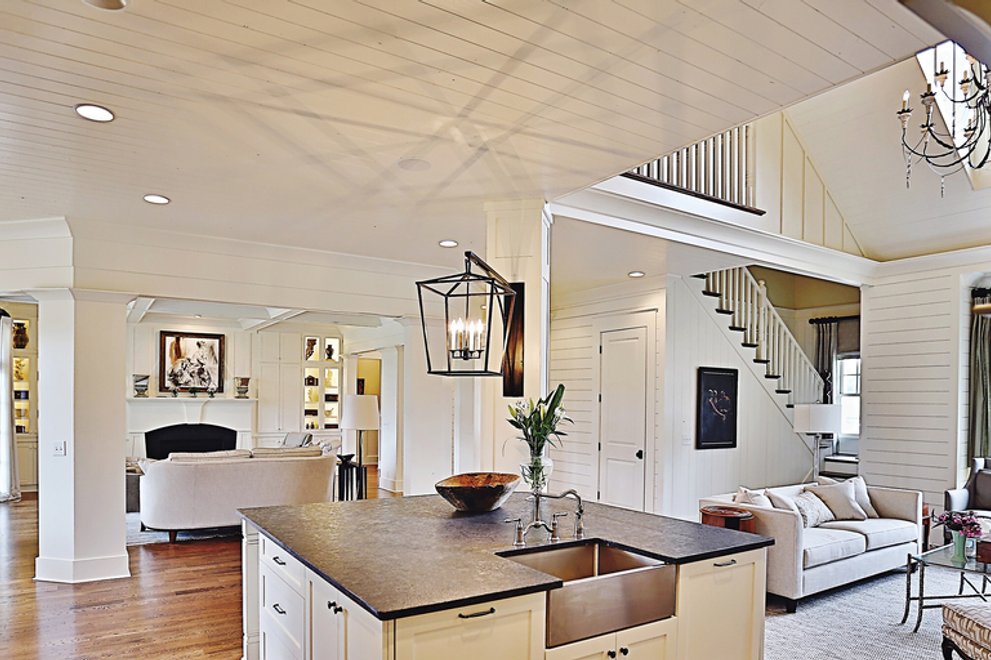Thinking Ahead to Holiday Parties
It would be a mistake to design an entire house around holiday meals and parties that only happen a few times a year. That said, plenty of new party-oriented homes are built each year for empty nesters in markets such as Palm Springs, Phoenix, and Dallas. The homes tend to have a big, central open space for gatherings that flows out onto a broad back porch, with a bar in the corner. That much open space may translate into wasted space for most families. They would be better served by a more intimate home that works for them day to day but is at the same time flexible enough to accommodate the occasional large gathering. The kitchen and great room in particular need to be optimized for family use since those spaces are used on a
daily basis. The good news is that, with some afore-thought, it’s possible to get the best of both worlds; as in Plan 917-41 by The Homestead Partners, where there is a den that can be used as a media room for when the family is alone, and a great room that will accommodate an extended family holiday dinner or the occasional party blowout.
It helps to have a large, open kitchen on the days when families and friends congregate in your home. If you plan on doing the cooking, you may need to set some boundaries, so you can pull bacon-wrapped shrimp out of the oven without guest
interference. An island is an ideal way to create a wall between food prep and social spaces, as shown in Plan 928-10 by Visbeen Associates. Islands, which have become fixtures in new home design, also come in handy for putting out appetizers and drinks during a party.
Circulation is something else to think about. As Dan Gregory points out in a post called Watch That Layout! the best house
plans provide two ways in and out of the living room, dining room, and kitchen -- as illustrated here with Plan 929-1 by Donald Gardner. See how you can move from kitchen to dining area to great room and back to kitchen; the guest suite also has two ways in and out. That way you can conveniently escape after you finish talking with someone. Similarly, if you plan to encourage visitors to go outside, it helps if the door to the porch or deck is located in the family room or great room. It’s less likely to be
used if it’s in the nook or bedroom. Parties are the one time when your entry hall is put to the test. It’s nice to have enough space to greet guests at the door. Ample front-hall closets used to be a given in new-home design. These days, you need to double-check to make sure they are big enough for guests to leave coats, gloves, hats, and maybe even boots. Having an office or guest room near the front door for leaving these items is a nice luxury, as illustrated by Gardner Plan 929-29, above.
The best parties are the ones where you can meet new people in informal social settings, engage in intimate conversations with friends, graze for food and drink, and maybe even watch a game. Achieving that level of enjoyment requires public rooms with a mix of settings – for standing and talking, sitting and conversing, eating, and television watching. It’s fun to think about how moving some furniture on party days might accommodate these functions.
Sports parties are a whole other ballgame (so to speak!). When I edited Builder magazine, we often hosted super bowl parties in show homes. Even though the game was running on multiple screens, guests tended to congregate around one screen in particular so that they could, in effect, watch the game together. It helped on those occasions when the main room for television watching borrowed space from another. Site lines are something else to consider. It’s nice at a big party when you can see from one room to another, especially if you are the host. If there’s someone you really want to connect with, you may be able to spot when that person is free. Or maybe there are two people you’d like to introduce. You can see whether they are in the same general vicinity.
Too many parties begin and end in the kitchen. One way to keep everyone from congregating there is to put food and drinks in other rooms. Bars, which are making a comeback in new home design, though they tend to be smaller today than they were 50 years ago, can really help in that respect. The layout
for Green Living Plan 497-46 shows a wet bar between the kitchen and the dining room, which is a very practical solution. The perfect spot for a bar may be in a corner of the great room that would be tough to furnish.
On the occasions when you expect people to sit down for a meal, it really helps if you can expand the dining room table. Many home plans today dispense with a formal dining room in favor of a designated
dining space within the great room, as shown here, also in Plan 497-46. That actually makes it easier to seat 10 or 12 people. You can add leaves to the table without running into walls. And there should be room for all-important serving tables.
People who entertain regularly may want a separate prep kitchen for the dirty work of cooking. These rooms, equipped with ovens, ranges, refrigeration, storage, and maybe even warming ovens, are great for caterers. They free the kitchen to be used as a party hangout. A second oven, even if it’s in the kitchen, comes in mighty handy on the days when you cook a roast or turkey for a large number of guests.






